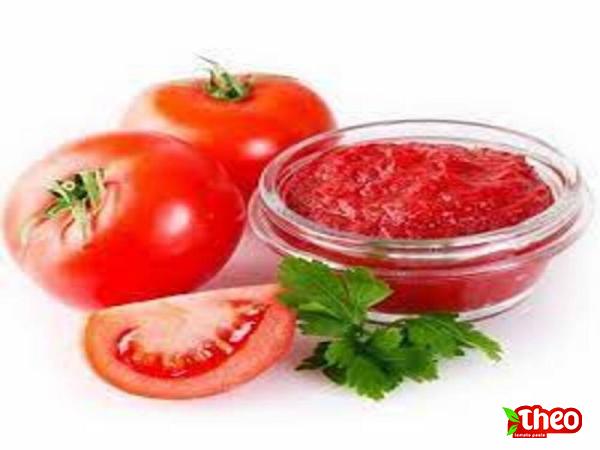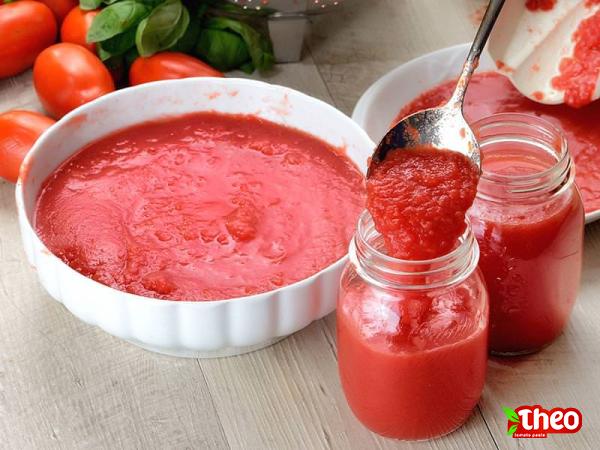Maximizing Freshness and Flavor of Tomatoes Introduction: Tomato paste is a popular ingredient in many cuisines across the globe. It is a concentrated form of tomatoes that adds depth, richness, and complexity to dishes. While tomato paste can be commercially produced using various methods, making your own tomato paste from fresh tomatoes offers numerous benefits. This article aims to explore the process of making tomato paste with fresh tomatoes, highlighting the advantages, techniques, and tips to achieve maximum freshness and flavor. Advantages of Making Tomato Paste with Fresh Tomatoes: 1. Superior Flavor and Aroma: Fresh tomatoes are bursting with natural flavors and aromatic compounds that can enhance the taste of any dish. By making tomato paste from fresh tomatoes, you can capture the true essence of ripe tomatoes and experience a more vibrant and robust flavor profile. 2. Health Benefits: Fresh tomatoes contain essential nutrients like lycopene, beta-carotene, vitamin C, and potassium. By utilizing fresh tomatoes in the preparation of tomato paste, these nutrients are retained, offering health benefits such as antioxidant properties, improved vision, and strengthened immunity. 3. Cost-effective: Making tomato paste from fresh tomatoes can be a cost-effective alternative to purchasing store-bought tomato paste. By utilizing surplus or seasonal tomatoes, you can save money and reduce food waste while enjoying the freshness of homegrown or local produce.

tomato paste
 Techniques and Tips for Making Tomato Paste with Fresh Tomatoes: 1. Choosing the Right Tomatoes: Opt for ripe, firm, and juicy tomatoes that are rich in color. Varieties such as Roma, San Marzano, and Amish Paste are commonly favored for their high levels of natural sweetness and lower water content. 2. Preparation and Blanching: Start by washing the tomatoes thoroughly and removing any blemishes. Then, score a small “X” on the bottom of each tomato and blanch them in boiling water for about 30 seconds to 1 minute. Immediately transfer the tomatoes to an ice bath to halt the cooking process. Blanching makes it easier to remove the skins. 3. Removing Skins and Seeds: Once the tomatoes are cooled, peel off the skins starting from the scored “X.” Cut the tomatoes in half and scoop out the seeds using a spoon or your fingers. Removing the seeds helps in reducing the water content and prevents the tomato paste from becoming too watery. 4. Cooking and Reducing: Chop the tomatoes into smaller pieces and add them to a heavy-bottomed pot or a slow cooker. Simmer the tomatoes on low heat, stirring occasionally to prevent burning. As the tomatoes cook, their water content will gradually evaporate, resulting in a reduction in volume and a thicker consistency. 5. Seasoning and Enhancing Flavor: For enhanced flavor, add salt, pepper, herbs like basil or oregano, garlic, onions, or other aromatics to the tomato paste during the cooking process. These additional ingredients can elevate the taste profile and create a more complex and nuanced flavor base. 6. Thickening the Paste: To achieve the desired thickness, continue cooking the tomatoes until the paste reaches your desired consistency. This can take several hours, depending on the water content of the tomatoes and the thickness you prefer. Stir frequently to prevent the paste from sticking to the bottom of the pot. 7. Storage and Preservation: Once the tomato paste reaches the desired consistency, allow it to cool completely before transferring it to sterilized jars or airtight containers. Store the tomato paste in the refrigerator for up to two weeks or freeze it for longer-term storage. Proper storage ensures that the quality and freshness of the tomato paste are preserved.
Techniques and Tips for Making Tomato Paste with Fresh Tomatoes: 1. Choosing the Right Tomatoes: Opt for ripe, firm, and juicy tomatoes that are rich in color. Varieties such as Roma, San Marzano, and Amish Paste are commonly favored for their high levels of natural sweetness and lower water content. 2. Preparation and Blanching: Start by washing the tomatoes thoroughly and removing any blemishes. Then, score a small “X” on the bottom of each tomato and blanch them in boiling water for about 30 seconds to 1 minute. Immediately transfer the tomatoes to an ice bath to halt the cooking process. Blanching makes it easier to remove the skins. 3. Removing Skins and Seeds: Once the tomatoes are cooled, peel off the skins starting from the scored “X.” Cut the tomatoes in half and scoop out the seeds using a spoon or your fingers. Removing the seeds helps in reducing the water content and prevents the tomato paste from becoming too watery. 4. Cooking and Reducing: Chop the tomatoes into smaller pieces and add them to a heavy-bottomed pot or a slow cooker. Simmer the tomatoes on low heat, stirring occasionally to prevent burning. As the tomatoes cook, their water content will gradually evaporate, resulting in a reduction in volume and a thicker consistency. 5. Seasoning and Enhancing Flavor: For enhanced flavor, add salt, pepper, herbs like basil or oregano, garlic, onions, or other aromatics to the tomato paste during the cooking process. These additional ingredients can elevate the taste profile and create a more complex and nuanced flavor base. 6. Thickening the Paste: To achieve the desired thickness, continue cooking the tomatoes until the paste reaches your desired consistency. This can take several hours, depending on the water content of the tomatoes and the thickness you prefer. Stir frequently to prevent the paste from sticking to the bottom of the pot. 7. Storage and Preservation: Once the tomato paste reaches the desired consistency, allow it to cool completely before transferring it to sterilized jars or airtight containers. Store the tomato paste in the refrigerator for up to two weeks or freeze it for longer-term storage. Proper storage ensures that the quality and freshness of the tomato paste are preserved.
Specifications of tomato paste
 Conclusion: Making tomato paste from fresh tomatoes offers culinary enthusiasts the opportunity to elevate their dishes with premium flavors while enjoying the health benefits of fresh produce. By following the techniques and tips outlined above, you can create homemade tomato paste that is bursting with the natural, vibrant, and robust flavors of ripe tomatoes. Whether you have a surplus of tomatoes from your garden or simply want to explore a cost-effective and flavorful alternative to store-bought options, making tomato paste from fresh tomatoes is a rewarding endeavor for any home cook. So, roll up your sleeves, grab some juicy tomatoes, and embark on a flavorsome journey with homemade tomato paste. Your taste buds will thank you!I. The Growing Demand for Tomato Paste: Tomato paste is a staple ingredient in a wide range of cuisines worldwide, and its popularity shows no signs of slowing down. The global demand for tomato paste is steadily increasing, driven by factors such as the growing awareness of the health benefits of tomatoes, the rise in vegan and vegetarian diets, and the versatility of tomato paste in various culinary applications. The demand for tomato paste is particularly strong in the food processing industry, where it is used as a key ingredient in the production of sauces, soups, stews, and other processed food products. The convenience and long shelf life of tomato paste make it a preferred choice for commercial food manufacturers. II. The Commercial Tomato Paste Production Process: Commercial tomato paste production typically involves large-scale industrial processes. The tomatoes are harvested, sorted, and washed before undergoing a series of steps, including blanching, peeling, and removing seeds. The tomato pulp is then concentrated through evaporation and further processed to achieve the desired texture and flavor. Finally, the tomato paste is packaged and distributed for wholesale and retail markets. III. Advantages of Making Tomato Paste with Fresh Tomatoes: 1. Quality Control: Making tomato paste from fresh tomatoes allows for better control over the quality of the final product. You can select the best tomatoes, monitor the cooking process, and adjust the seasonings to your taste preferences. 2. Transparency and Authenticity: By making your own tomato paste, you know exactly what goes into it. This ensures transparency and eliminates any concerns about artificial additives, preservatives, or excessive salt content that may be present in some commercial brands.
Conclusion: Making tomato paste from fresh tomatoes offers culinary enthusiasts the opportunity to elevate their dishes with premium flavors while enjoying the health benefits of fresh produce. By following the techniques and tips outlined above, you can create homemade tomato paste that is bursting with the natural, vibrant, and robust flavors of ripe tomatoes. Whether you have a surplus of tomatoes from your garden or simply want to explore a cost-effective and flavorful alternative to store-bought options, making tomato paste from fresh tomatoes is a rewarding endeavor for any home cook. So, roll up your sleeves, grab some juicy tomatoes, and embark on a flavorsome journey with homemade tomato paste. Your taste buds will thank you!I. The Growing Demand for Tomato Paste: Tomato paste is a staple ingredient in a wide range of cuisines worldwide, and its popularity shows no signs of slowing down. The global demand for tomato paste is steadily increasing, driven by factors such as the growing awareness of the health benefits of tomatoes, the rise in vegan and vegetarian diets, and the versatility of tomato paste in various culinary applications. The demand for tomato paste is particularly strong in the food processing industry, where it is used as a key ingredient in the production of sauces, soups, stews, and other processed food products. The convenience and long shelf life of tomato paste make it a preferred choice for commercial food manufacturers. II. The Commercial Tomato Paste Production Process: Commercial tomato paste production typically involves large-scale industrial processes. The tomatoes are harvested, sorted, and washed before undergoing a series of steps, including blanching, peeling, and removing seeds. The tomato pulp is then concentrated through evaporation and further processed to achieve the desired texture and flavor. Finally, the tomato paste is packaged and distributed for wholesale and retail markets. III. Advantages of Making Tomato Paste with Fresh Tomatoes: 1. Quality Control: Making tomato paste from fresh tomatoes allows for better control over the quality of the final product. You can select the best tomatoes, monitor the cooking process, and adjust the seasonings to your taste preferences. 2. Transparency and Authenticity: By making your own tomato paste, you know exactly what goes into it. This ensures transparency and eliminates any concerns about artificial additives, preservatives, or excessive salt content that may be present in some commercial brands.
buy tomato paste
 3. Tailored Flavor Profile: Homemade tomato paste allows you to customize the flavor by choosing specific tomato varieties, adjusting the seasoning, and experimenting with additional herbs and spices. This flexibility enables you to create a signature tomato paste that suits your palate and complements your recipes perfectly. 4. Local and Sustainable Sourcing: Making tomato paste with fresh tomatoes gives you the opportunity to support local farmers and promote sustainable agriculture. By sourcing tomatoes from local markets or growing them in your backyard, you reduce the carbon footprint associated with long-distance transportation and contribute to the reduction of food waste. IV. Marketing Opportunities for Homemade Tomato Paste: 1. Niche Market Appeal: Homemade products have gained popularity in recent years, with consumers seeking unique, artisanal offerings. Positioning your homemade tomato paste as a premium, artisanal product can attract customers who appreciate the authentic, handcrafted approach. 2. Health-conscious Market: The trend towards healthier eating habits presents an opportunity to market homemade tomato paste as a nutritious alternative to store-bought options. Highlight the use of fresh, organic ingredients and the absence of artificial additives to appeal to health-conscious consumers. 3. Local Food Movements: Cater to the increasing demand for locally-sourced and sustainable food products by positioning your homemade tomato paste as a locally-made, eco-friendly choice. Collaborate with farmers’ markets, restaurants, and health food stores to reach a wider audience and tap into the local food movement. V. Packaging and Branding: Choose packaging materials that are suitable for preserving the freshness and flavor of your homemade tomato paste. Glass jars or BPA-free plastic containers with airtight seals are often preferred options. Consider branding your product with a catchy name, unique labeling, and appealing design to differentiate your homemade tomato paste from competitors and attract customers. VI. Distribution Channels: Explore various distribution channels to reach your target audience. In addition to selling directly to customers, consider selling through local grocery stores, specialty food shops, farmers’ markets, or online platforms. Networking with local chefs, restaurants, and caterers can also lead to bulk sales or partnerships. VII. Marketing Strategies: 1. Social Media Presence: Create an engaging social media presence to showcase your homemade tomato paste. Share recipes, cooking tips, and behind-the-scenes glimpses of your production process to build brand awareness and attract followers. 2. Recipe Collaboration: Collaborate with food bloggers, influencers, and chefs to feature your homemade tomato paste in their recipes. This can expose your product to their established audience, generate buzz, and increase brand recognition. 3. Tasting Events: Organize tasting events at local markets or culinary fairs to introduce your homemade tomato paste to potential customers. Allow them to sample various recipes made with your product, and provide information about its unique qualities and health benefits. VIII. Overcoming Challenges: Producing homemade tomato paste on a larger scale can present challenges such as maintaining consistent quality, sourcing a steady supply of fresh tomatoes, and managing production efficiency. Consider investing in appropriate equipment, such as food processors or commercial blenders, to streamline the process and ensure high-quality results. IX. Compliance and Regulations: Ensure that your homemade tomato paste complies with local health and safety regulations. Obtain appropriate licenses, permits, and certifications to operate legally and build trust with consumers. Adhere to proper hygiene practices, labeling requirements, and food safety guidelines throughout the manufacturing process. X. Building Customer Loyalty: To build lasting customer loyalty, focus on delivering a high-quality product consistently. Encourage feedback, listen to customer preferences, and adapt your product accordingly. Offer incentives such as loyalty programs, special promotions, or discounts for repeat customers to encourage brand loyalty and word-of-mouth referrals. Conclusion: Making tomato paste with fresh tomatoes offers numerous advantages, from superior flavor and customized recipes to marketing opportunities in niche markets. By following best practices in sourcing, production, packaging, marketing, and distribution, you can create a unique homemade tomato paste that stands out in the competitive food industry. Remember to prioritize quality, innovation, and customer satisfaction to establish a successful and sustainable business.
3. Tailored Flavor Profile: Homemade tomato paste allows you to customize the flavor by choosing specific tomato varieties, adjusting the seasoning, and experimenting with additional herbs and spices. This flexibility enables you to create a signature tomato paste that suits your palate and complements your recipes perfectly. 4. Local and Sustainable Sourcing: Making tomato paste with fresh tomatoes gives you the opportunity to support local farmers and promote sustainable agriculture. By sourcing tomatoes from local markets or growing them in your backyard, you reduce the carbon footprint associated with long-distance transportation and contribute to the reduction of food waste. IV. Marketing Opportunities for Homemade Tomato Paste: 1. Niche Market Appeal: Homemade products have gained popularity in recent years, with consumers seeking unique, artisanal offerings. Positioning your homemade tomato paste as a premium, artisanal product can attract customers who appreciate the authentic, handcrafted approach. 2. Health-conscious Market: The trend towards healthier eating habits presents an opportunity to market homemade tomato paste as a nutritious alternative to store-bought options. Highlight the use of fresh, organic ingredients and the absence of artificial additives to appeal to health-conscious consumers. 3. Local Food Movements: Cater to the increasing demand for locally-sourced and sustainable food products by positioning your homemade tomato paste as a locally-made, eco-friendly choice. Collaborate with farmers’ markets, restaurants, and health food stores to reach a wider audience and tap into the local food movement. V. Packaging and Branding: Choose packaging materials that are suitable for preserving the freshness and flavor of your homemade tomato paste. Glass jars or BPA-free plastic containers with airtight seals are often preferred options. Consider branding your product with a catchy name, unique labeling, and appealing design to differentiate your homemade tomato paste from competitors and attract customers. VI. Distribution Channels: Explore various distribution channels to reach your target audience. In addition to selling directly to customers, consider selling through local grocery stores, specialty food shops, farmers’ markets, or online platforms. Networking with local chefs, restaurants, and caterers can also lead to bulk sales or partnerships. VII. Marketing Strategies: 1. Social Media Presence: Create an engaging social media presence to showcase your homemade tomato paste. Share recipes, cooking tips, and behind-the-scenes glimpses of your production process to build brand awareness and attract followers. 2. Recipe Collaboration: Collaborate with food bloggers, influencers, and chefs to feature your homemade tomato paste in their recipes. This can expose your product to their established audience, generate buzz, and increase brand recognition. 3. Tasting Events: Organize tasting events at local markets or culinary fairs to introduce your homemade tomato paste to potential customers. Allow them to sample various recipes made with your product, and provide information about its unique qualities and health benefits. VIII. Overcoming Challenges: Producing homemade tomato paste on a larger scale can present challenges such as maintaining consistent quality, sourcing a steady supply of fresh tomatoes, and managing production efficiency. Consider investing in appropriate equipment, such as food processors or commercial blenders, to streamline the process and ensure high-quality results. IX. Compliance and Regulations: Ensure that your homemade tomato paste complies with local health and safety regulations. Obtain appropriate licenses, permits, and certifications to operate legally and build trust with consumers. Adhere to proper hygiene practices, labeling requirements, and food safety guidelines throughout the manufacturing process. X. Building Customer Loyalty: To build lasting customer loyalty, focus on delivering a high-quality product consistently. Encourage feedback, listen to customer preferences, and adapt your product accordingly. Offer incentives such as loyalty programs, special promotions, or discounts for repeat customers to encourage brand loyalty and word-of-mouth referrals. Conclusion: Making tomato paste with fresh tomatoes offers numerous advantages, from superior flavor and customized recipes to marketing opportunities in niche markets. By following best practices in sourcing, production, packaging, marketing, and distribution, you can create a unique homemade tomato paste that stands out in the competitive food industry. Remember to prioritize quality, innovation, and customer satisfaction to establish a successful and sustainable business.




